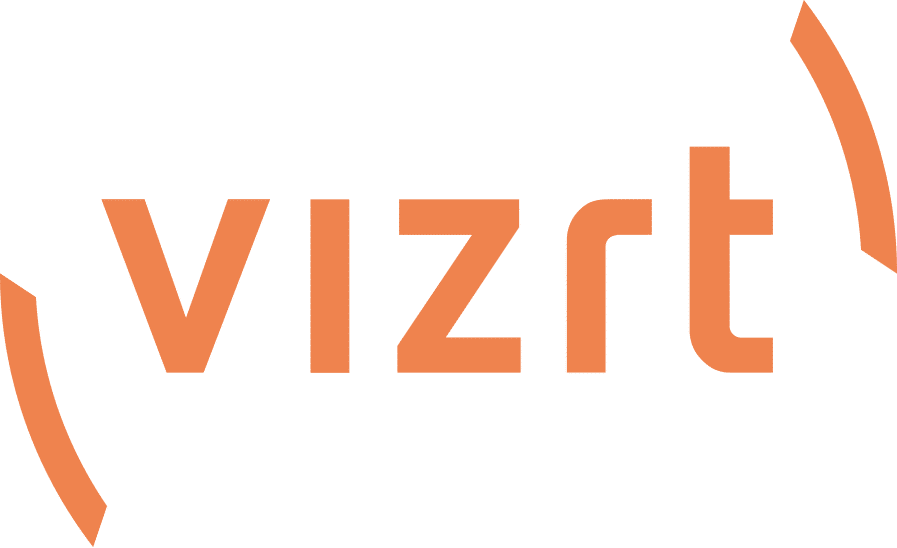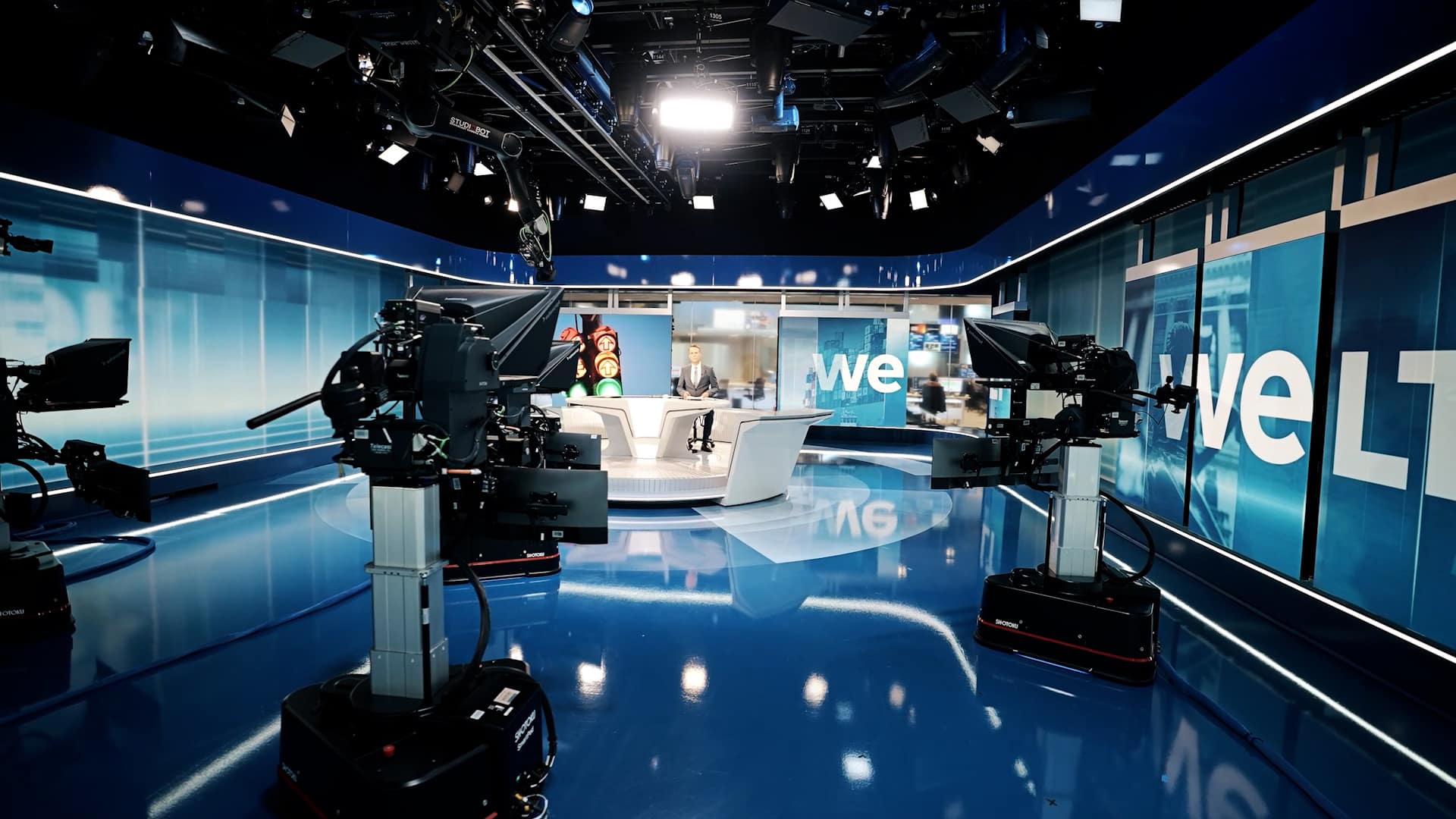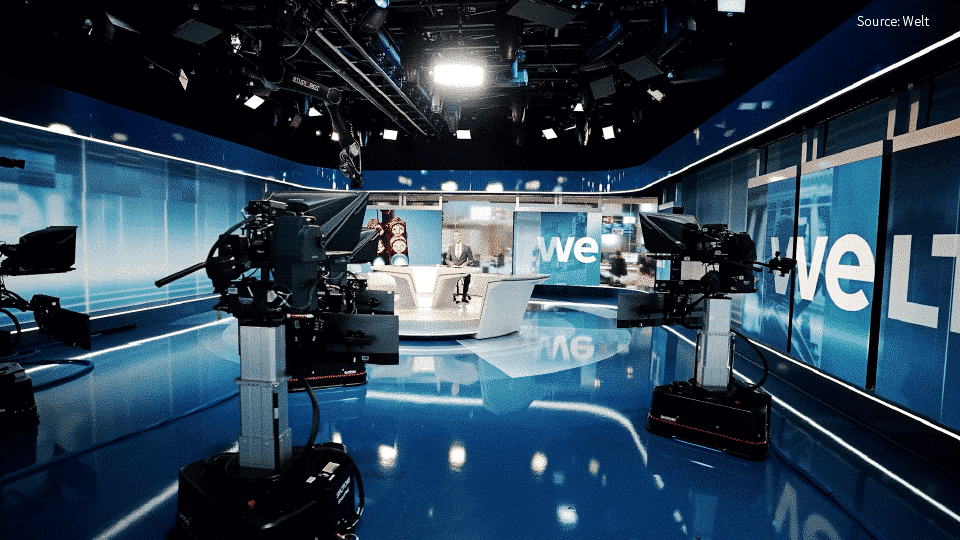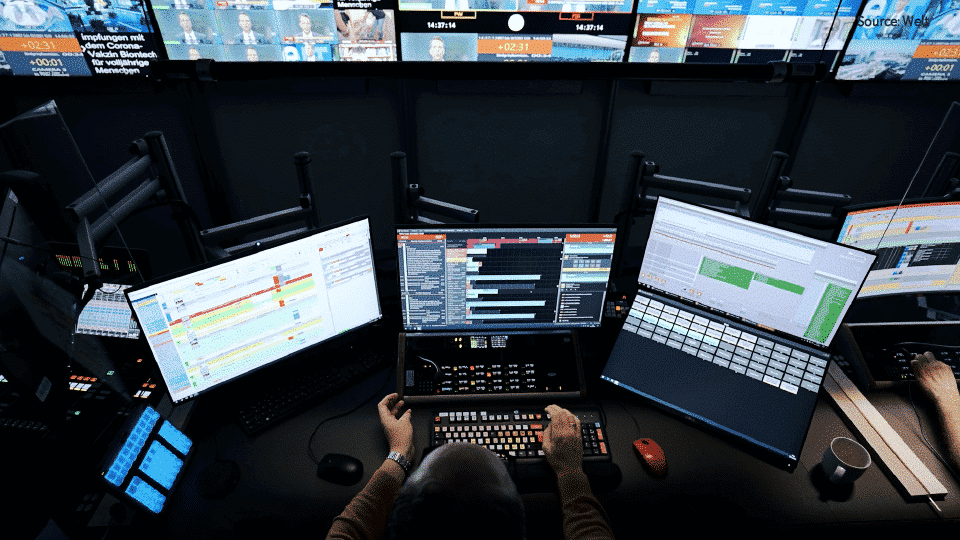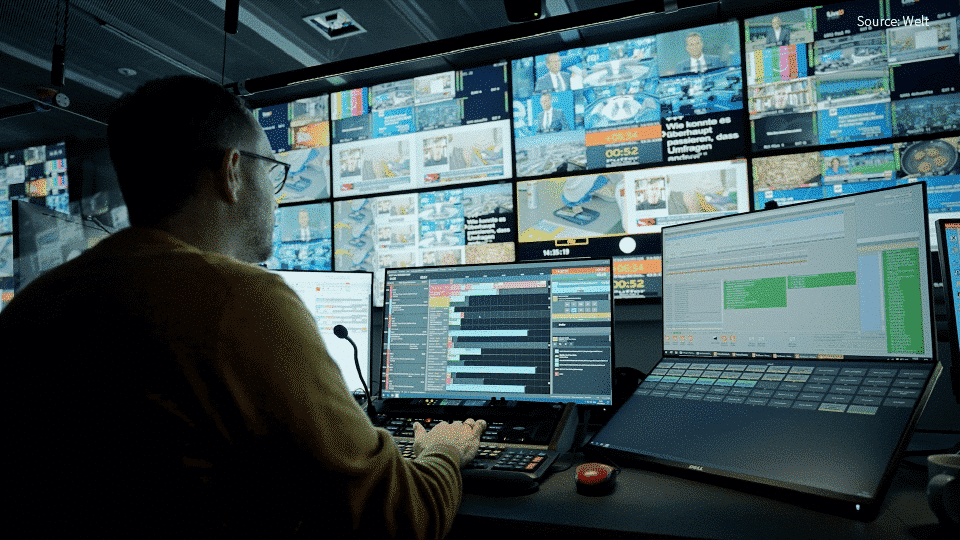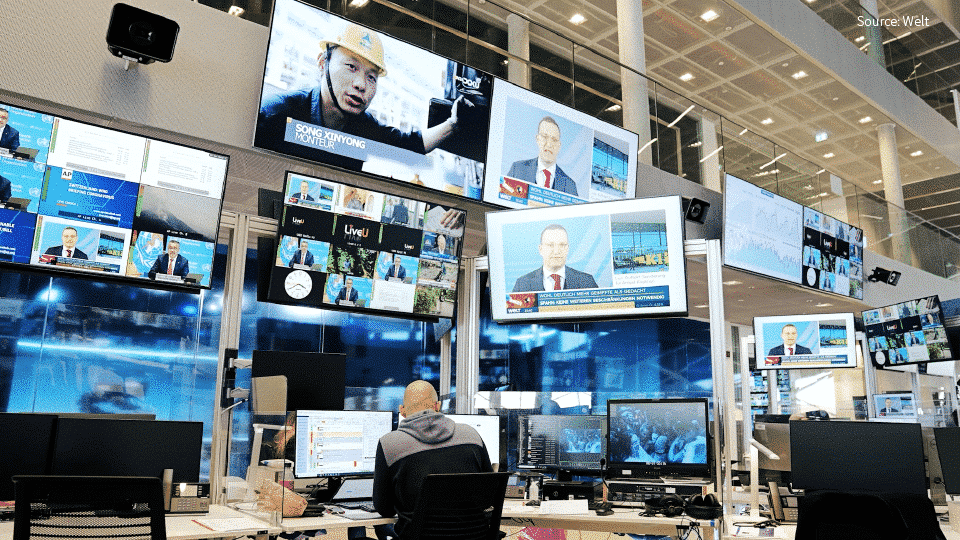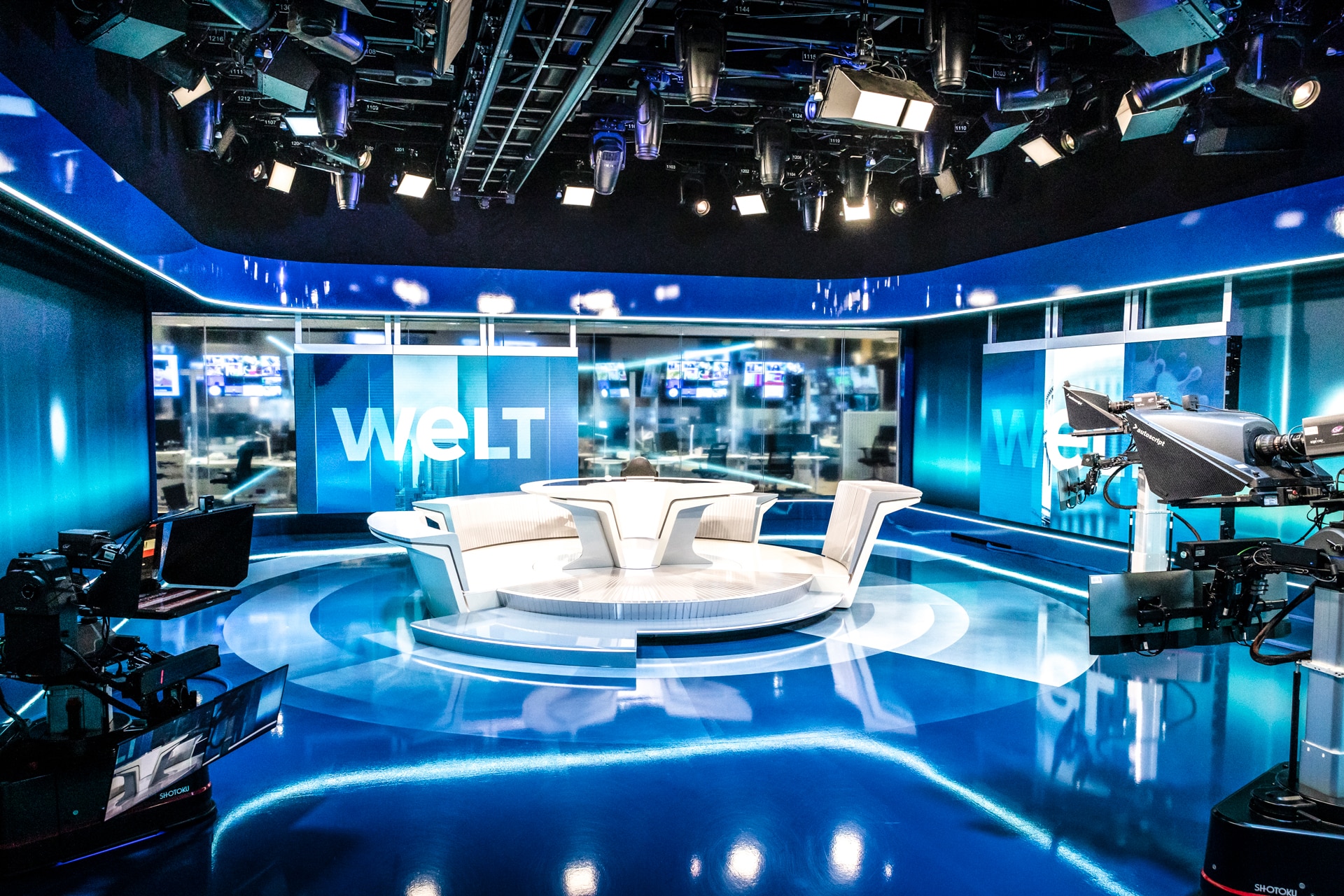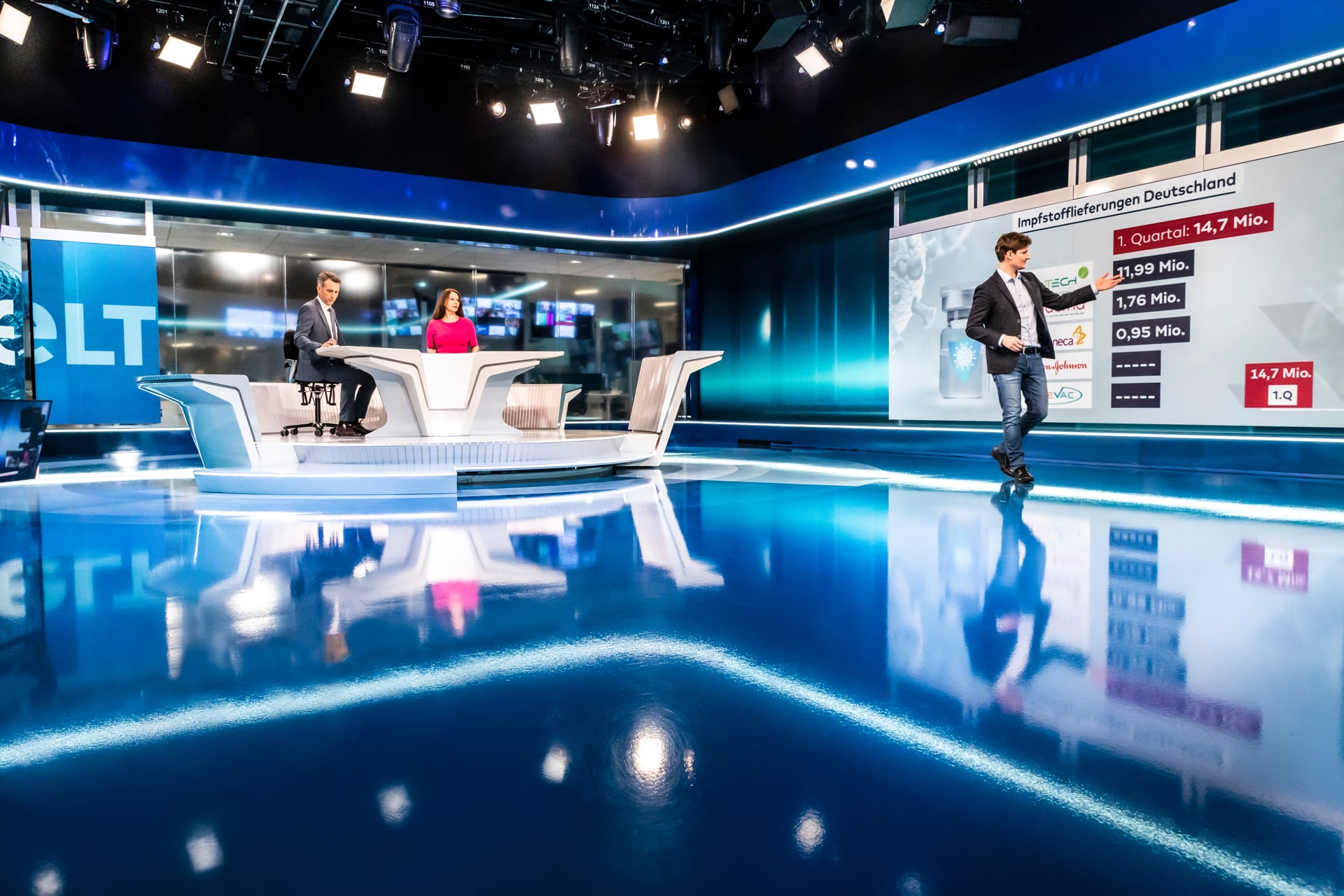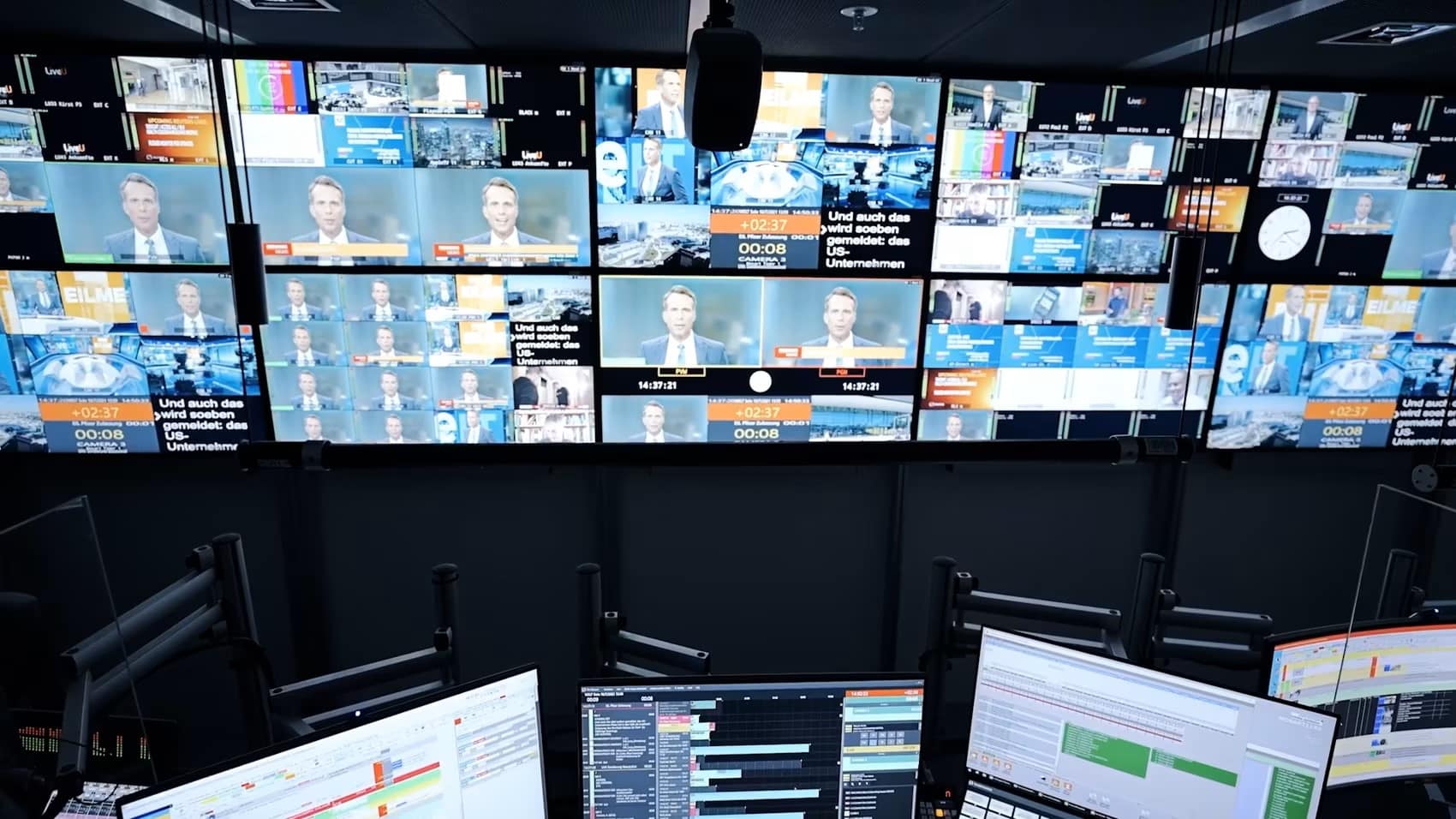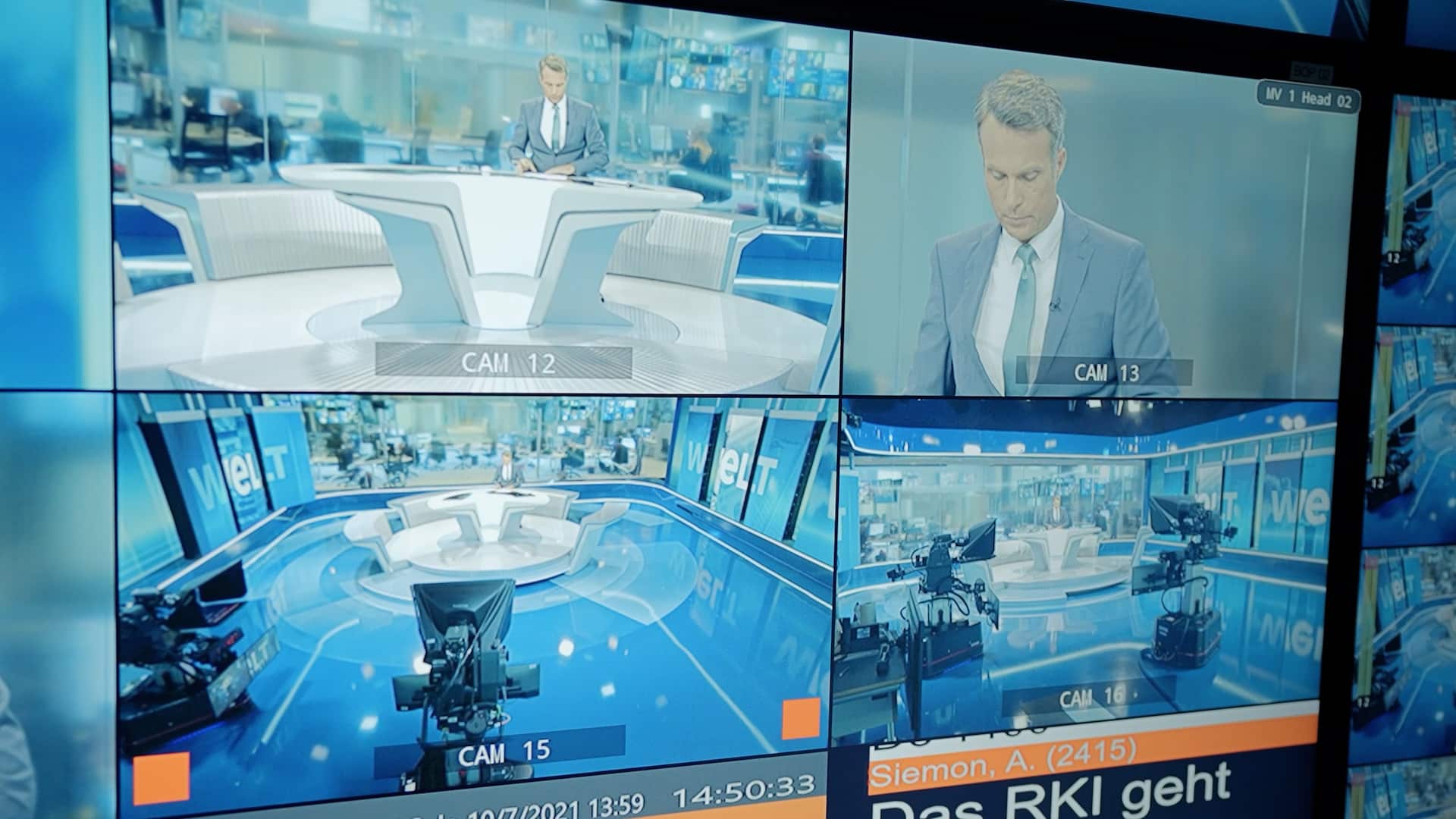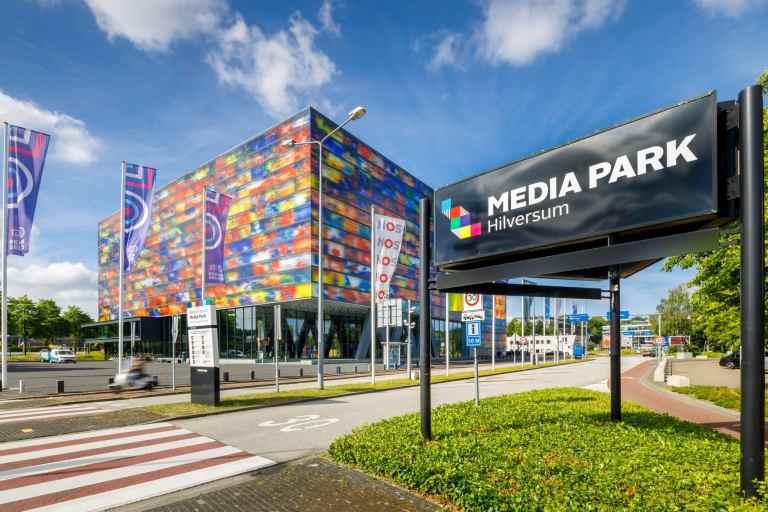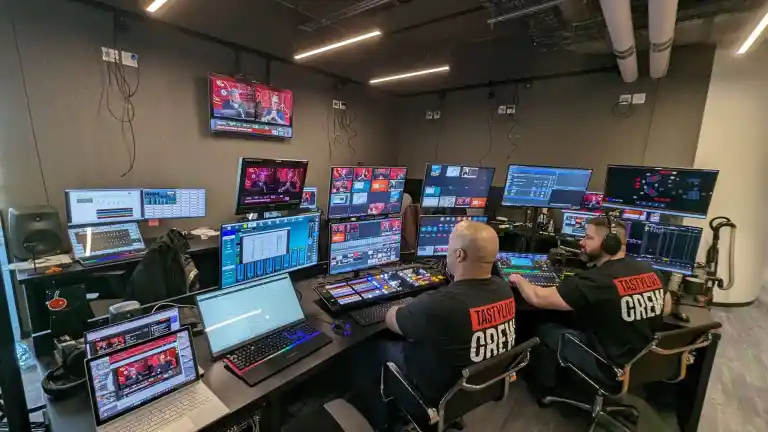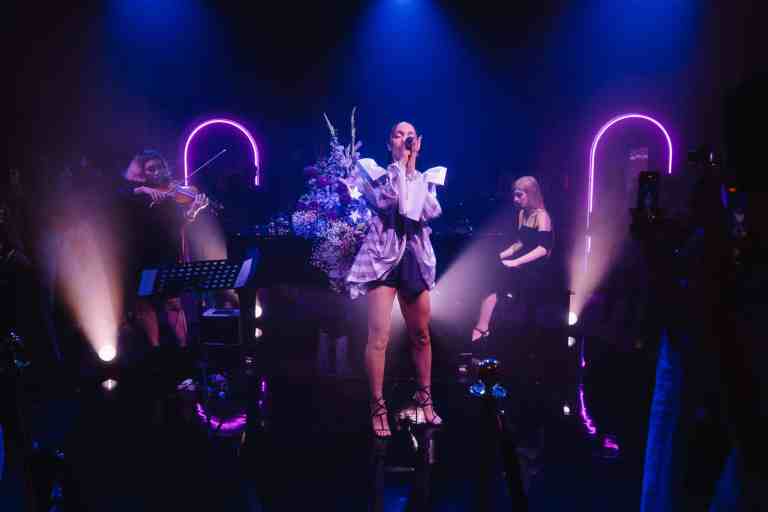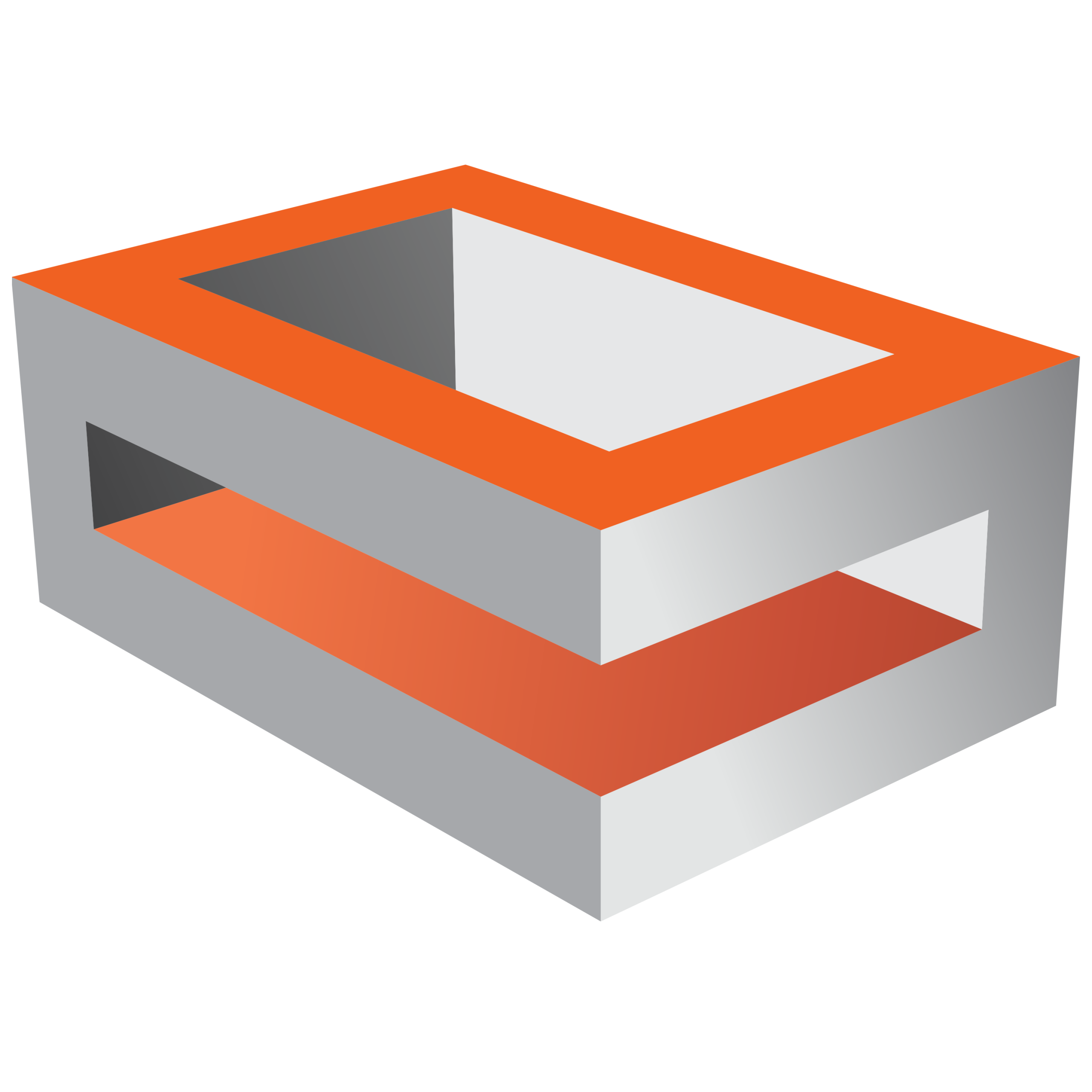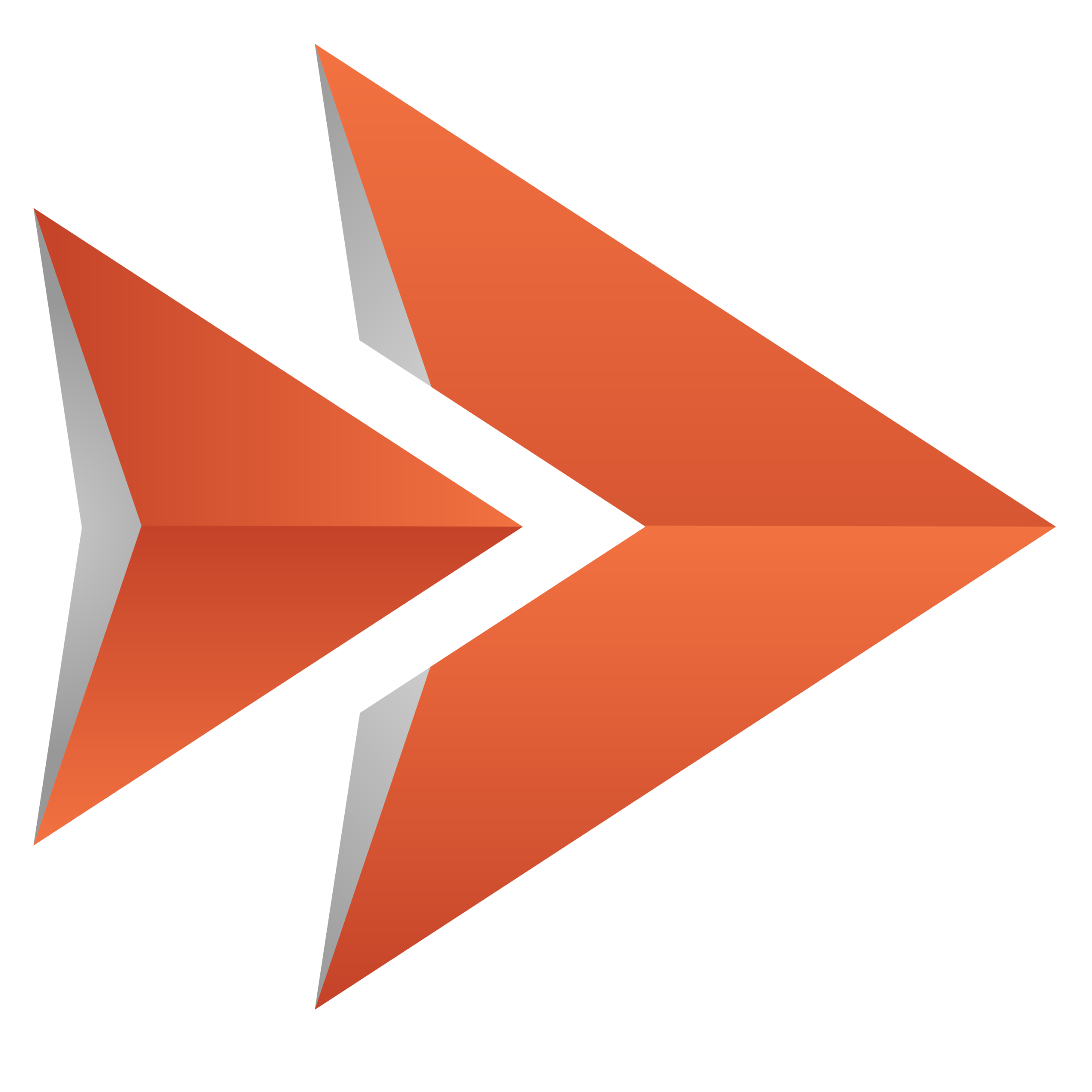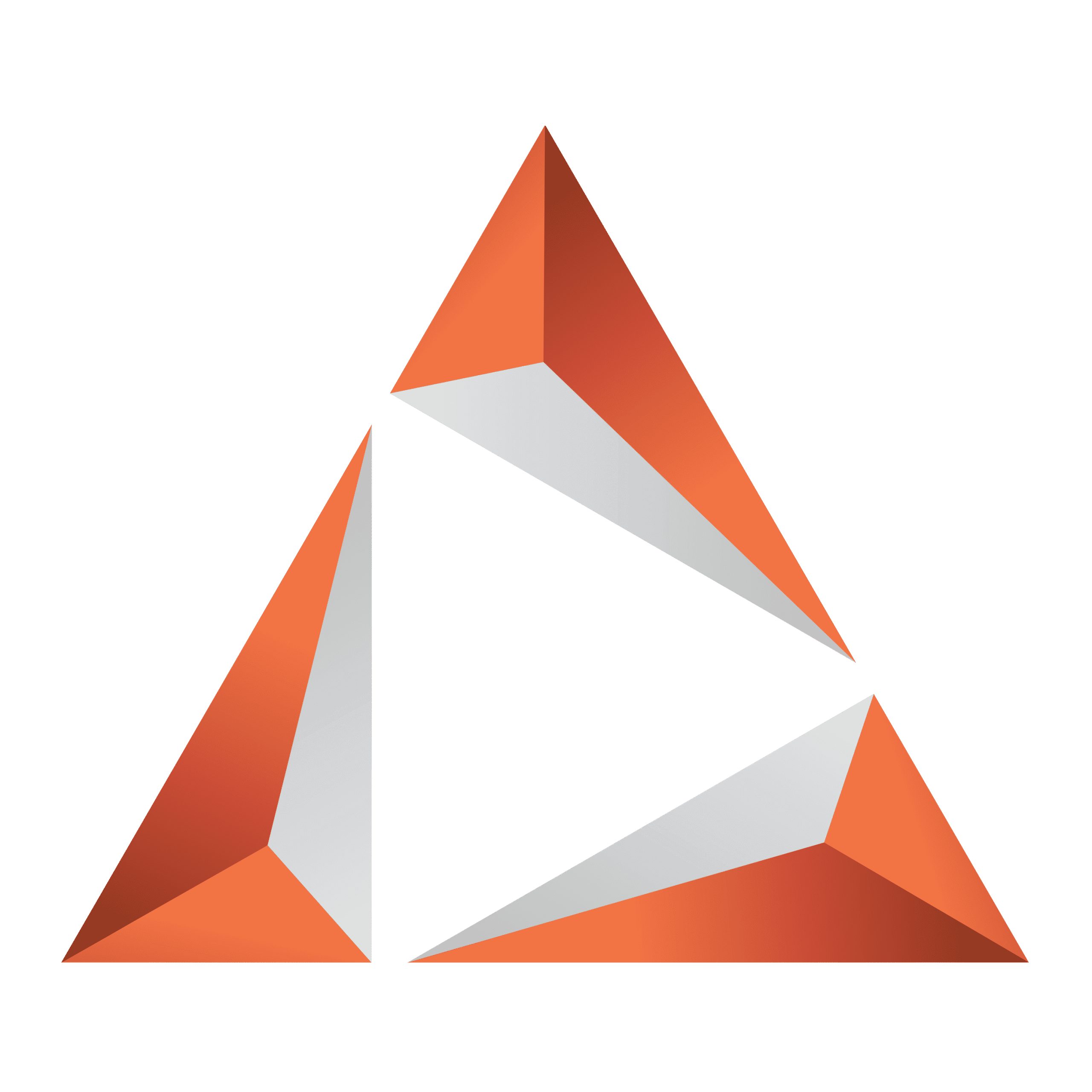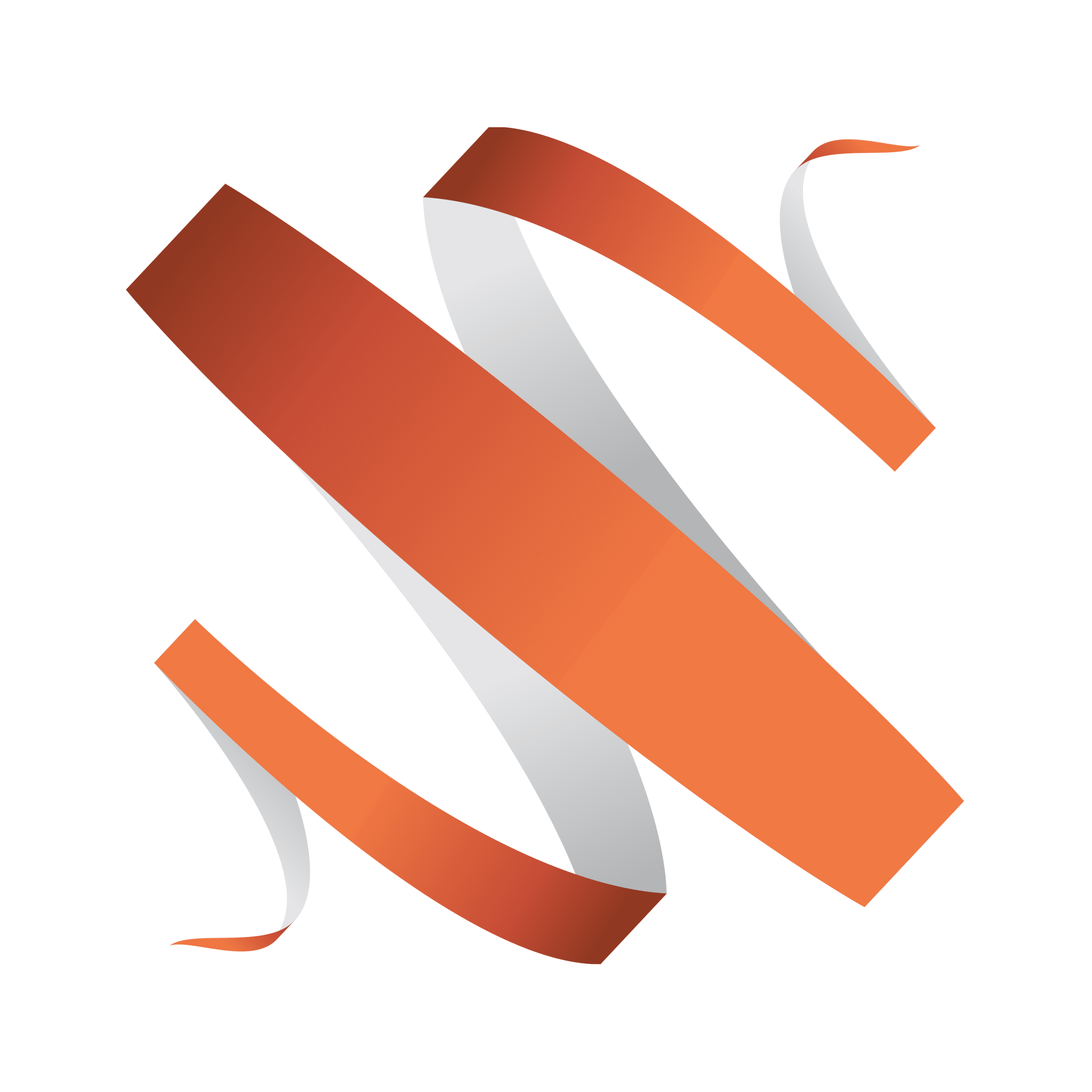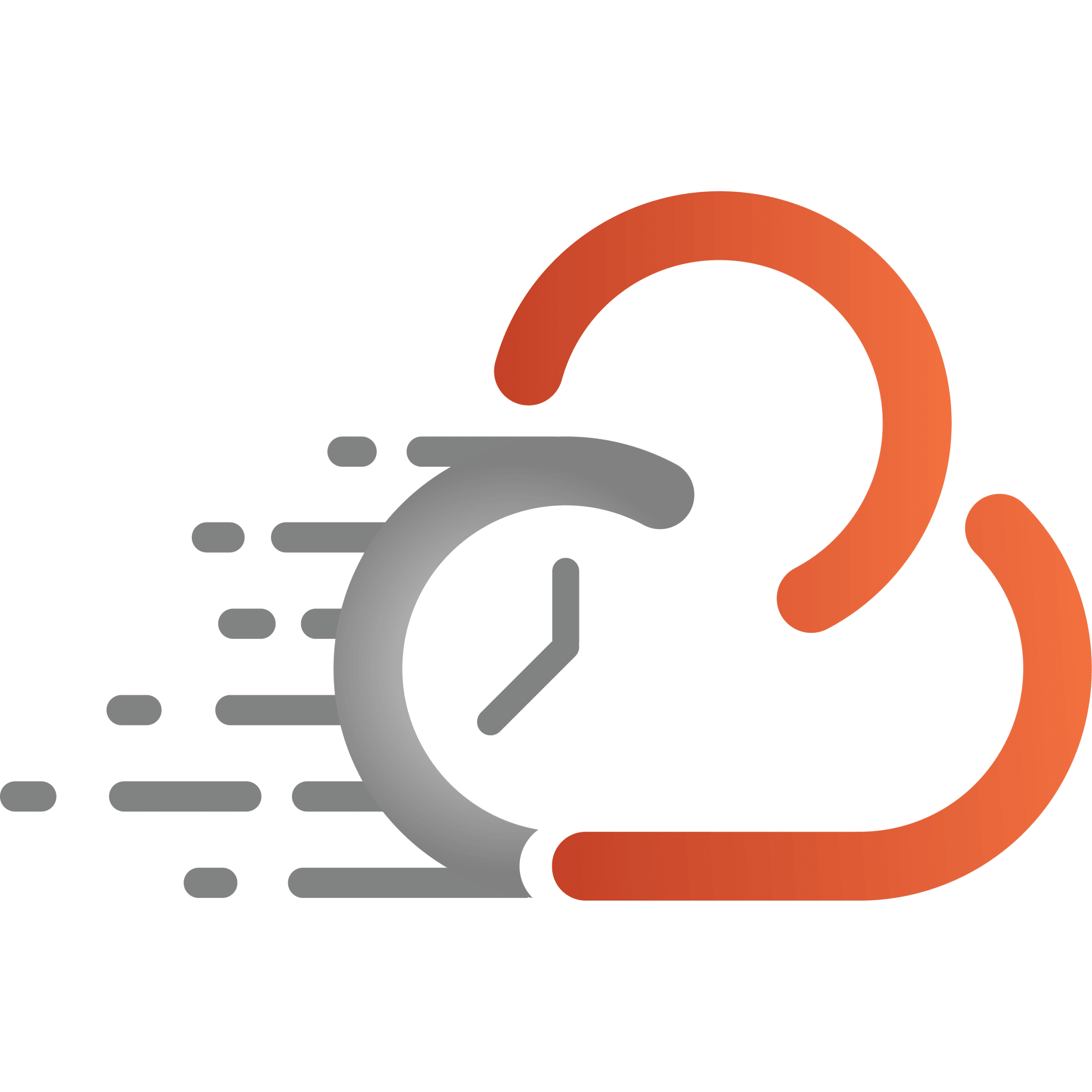The free-to-air news channel runs 24/7 and provides regular news updates to other German channels. The WELT team, led by CTO Thorsten Prohm, Technical Lead, Ralf Hünefeld, and Senior Director Philipp Kern took the move as an opportunity to completely reinvent its infrastructure and at the same time allow it to make studio presentations graphically stunning.
Welt’s requirements-creativity enhancement with simplified technology
Creativity enhancements with simplified technology. “WELT had several ideas, both creative and technical,” says Philipp Kern. “The creative ideas included a hybrid augmented reality (AR) studio and a physical studio with different creative layers, such as moving LED screens with content that can be in different positions and configurations around the studio, a cycloramic LED backdrop, and AR graphics”.
WELT wanted a unified workflow that would simplify and control the many inputs and outputs for production at the touch of a button. It needed redundant systems for operational security but didn’t want the rack space crowded out with extra hardware. In short, it wanted to have more flexibility while depending on fewer components.
“We wanted to give the day-to-day production the possibility to take all the media elements and put it together in a form they wanted and give the journalists the ability to put their ideas directly on screen,” adds Kern.
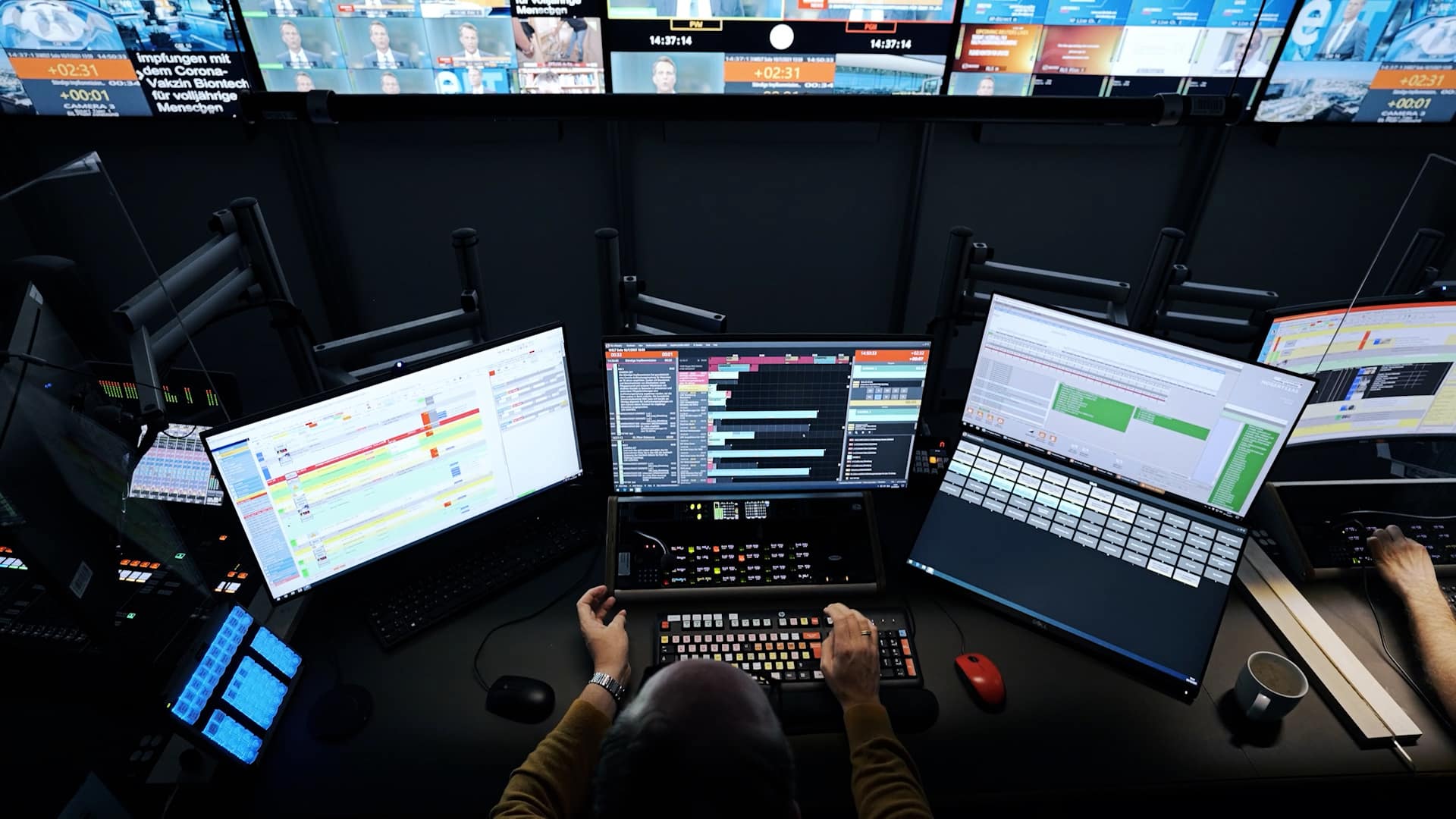
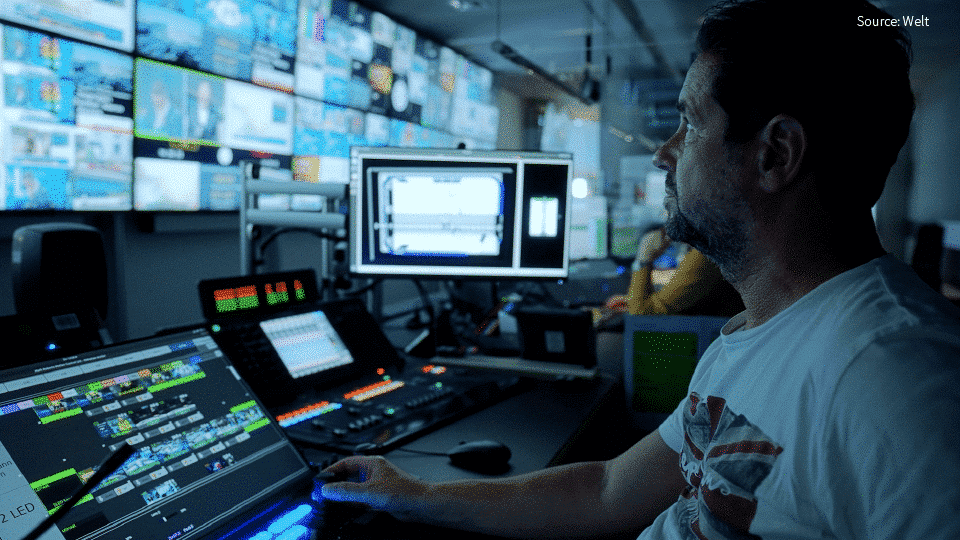
This is where your amazing photo caption will go. Hide or delete the Row to remove if needed.
Automation
WELT wished to have a studio that offered maximum automation through robotic cameras and IP-controlled lighting systems. The moving LED panels, which could be arranged to form different backdrops, would need to be filled with content as well as maneuver according to the needs of production. WELT also wanted to be able to switch over to a completely virtual studio newscast in a matter of seconds or transition seamlessly when adding live sources as contributors to a current broadcast and redesign the screen on the fly.
All this would demand precise control and a lot of material to be generated, not just the normal news show media such as video feeds and graphic overlays, but the content for the screens and backdrop, the virtual studio, and the AR graphics. WELT wanted more scope for creativity but also required less complex routes to deploy and update its graphics output.
The challenges
“We had the problem of constantly moving visual data, such as that originating from the creative department using Cinema4D, moving that into Vizrt or another graphic system and then moving that into Viz Mosart which then fed the video switcher. This meant the original creative assets were being translated a second or third time,” says Kern. It was plain to see that modern storytelling might end up involving a lot of extra complexity, and a lot of hardware.
Solutions
However, the WELT team was thinking outside the box. Rather than have fixed hardware components routed through copper SDI to a hardware mixer in the gallery, they saw the potential in software, namely a SMPTE 2110 NMOS-based networked solution to build on the automation already in place.
“We had the idea to input the graphics directly into software and control all the broadcast media in one real-time software environment,” says Kern. Vizrt offers an advanced range of software solutions for media management, automation, and graphics that the broadcast engineers at WELT were already very familiar with. A long-established relationship has seen Vizrt develop specialized solutions for WELT over the past twenty years. Thanks to tools such as Viz Mosart the daily production was completely automated and each pre-planned news show required only two to three people in the gallery.
Customized unified workflows
“They wanted to have more unification,” adds Lang. “So, we had to create unified feeds for the LED panels and monitors inside the studios, to drive the virtual set and define the look and feel of the programs, as well as deliver the graphics that are needed to tell their stories. We wanted to streamline their operation to use very little components, so they were not trying to orchestrate a huge amount of technology to get to a certain look and feel.”
“Their idea was to integrate a lot of the workflows into one centralized solution and replace the hardware-based studio mixer with a software-based mixer,” says Adrian Fiedrich, R&D Project Manager at Vizrt. “We saw how we could modify and extend components to meet the new ST 2110-based workflow, and of course add a lot of new features to fit the customer’s needs. It’s a very tailored solution for WELT. Certain software components had to be introduced because those devices didn’t exist before and other products updated, but everything, all the various components, all the routing, is controlled by Vizrt products.”
In a traditional live studio environment, a vision mixer panel allows the operator to bring in and cue up media from video servers, graphics servers, clip servers, and live camera sources, all routed via copper cables.
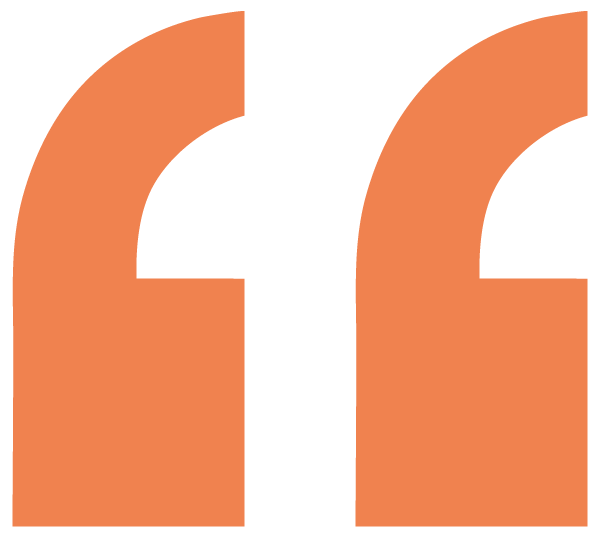
Viz Engines influencing event-based logic
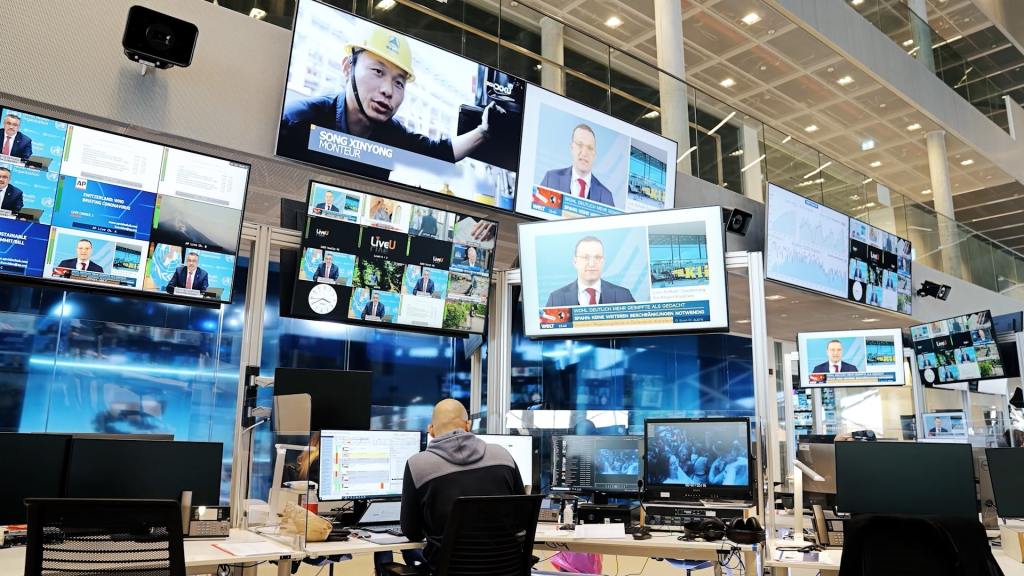
Everything runs on event-based logic, with Viz Engine providing the power. “Each gallery has at least four Viz Engines just independently switching network streams, all the time whenever they need,” says Fiedrich. “A new plug-in architecture was developed for the engine which takes care of requesting the source from the network, they talk to the system orchestrator which talks to the routers and it gets proper feedback as soon as the sources are switched.”

The whole system has a one-to-one redundancy. For example, it contains two vision mixers in parallel, always producing the same output. So, at any time, WELT can switch over to the backup and just keep producing the same show with the same functionality. Plugins listen to hardware inputs and will switch things over if something goes wrong. The system doesn’t rely on hardware with a fixed number of inputs or outputs. Instead, it can have many ‘instances’ running on the same machine to provide different kinds of output, such as a different aspect ratio. It can thus be easily scaled up not only in size but also in functionality. Viz Engine supports WELT’s seven cameras because of the way the mixer-less workflow can switch them. “Camera control is something we’ve been doing for years,” says Fiedrich. “This system just asks them to select the cameras they want to have, and the camera positions are handled by the robotic interface.”
Software-Driven automation
Due to the software-based environment, previously discrete devices can communicate with each other a lot more. So the vision mixer can talk to the camera tracking system as well as drive functions like tallies. It’s a similar setup for the IP-controlled lights; the system just wants to know which lights to use and the brightness levels and everything is automated.
The massive cyclorama video wall is also driven by Viz engine. It can be controlled directly via Viz Multiplay or automated by Viz Mosart.
“You can have the whole program rundown completely automated or have an operator hitting ‘next’. But there is no hardware vision mixer, and no panel and no copper-based routing, because the switching at the backend is all now completely dynamic,” says Fiedrich.
“As soon as you accept the rundown, then all you need to do is press play,” he continues. “You no longer need the person who controls the audio mixer because this is done by Viz Mosart; there is no video mixer because the engine itself knows what comes next and mixes it. It handles all the content, such as combining graphics and clips and compositing different layers of graphics on top. It all just switches.”
An eco-friendly practice
Sustainability concerns are also satisfied. “If you look into the WELT server room where the hardware now sits, there are just standard HP machines pulling a few hundred watts, rather than the power required for hardware video and audio servers, clip servers, and huge mixer panels,” Fiedrich adds. “They only need a rack, instead of a whole room.”
Tried and tested
The full development period was one and a half years, much of which took place during the lockdown and social distancing restrictions Germany was operating under due to COVID-19. However, work advanced greatly from October 2020 to April 2021, with Vizrt and WELT teams working together with solution integrator, Qvest Media.
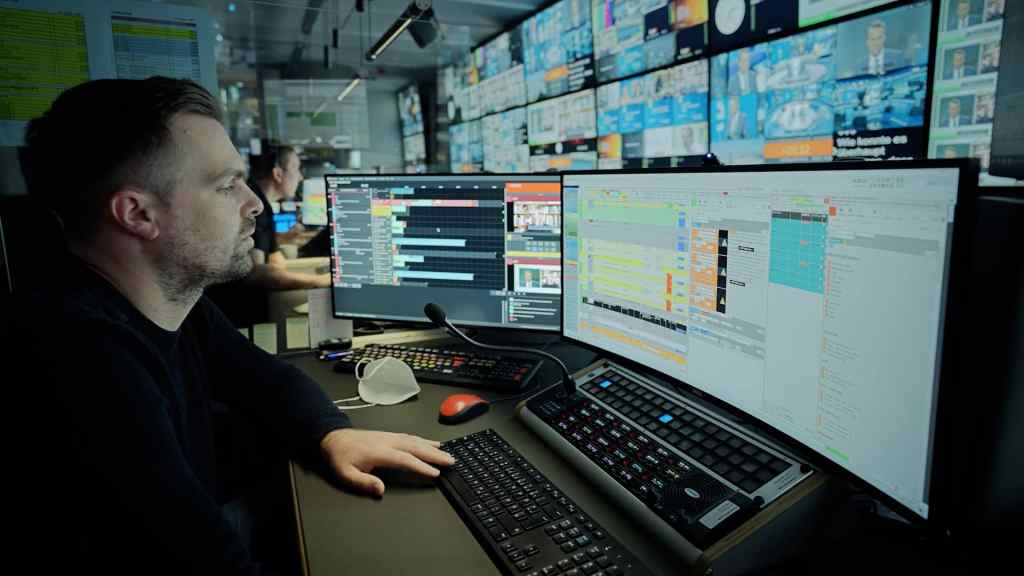
“WELT was the first to think about these particular dynamic workflows at this scale,” says Fiedrich. “So we had to be the first to have to find the solutions. There was already a huge level of trust in us to achieve the things they wanted to do. It was good to have such a strong partner because what we are doing at WELT hasn’t been done anywhere before.”
“But the best thing we’ve heard is some of the users saying there’s no difference between a real video switcher and the Vizrt software.”
“This solution has run since April 24 without any problems at all. It’s incredible.” “The journalists have more direct responsibility for the show and it gives the day-to-day production more possibilities when putting the show elements together. We are now working with colleagues to integrate the virtual environment in Studio 2 with a real environment,” adds Philipp.
Although the system very much reflects what WELT originally requested, and so is tailored to that customer, the Vizrt components have been developed to be easy to adapt to the needs of other customers.
“We see this project as the prototype for this way of working,” says Fiedrich. “There are already other customers in Germany who are starting to create some test setups on a smaller scale, and we are looking at how the system can work for them.”
Vizrt Case Study
WELT switches to a software-defined vision with Vizrt
The free-to-air news channel runs 24/7 and provides regular news updates to other German channels. The WELT team, led by CTO Thorsten Prohm, Technical Lead, Ralf Hünefeld, and Senior Director Philipp Kern took the move as an opportunity to completely reinvent its infrastructure and at the same time allow it to make studio presentations graphically stunning.
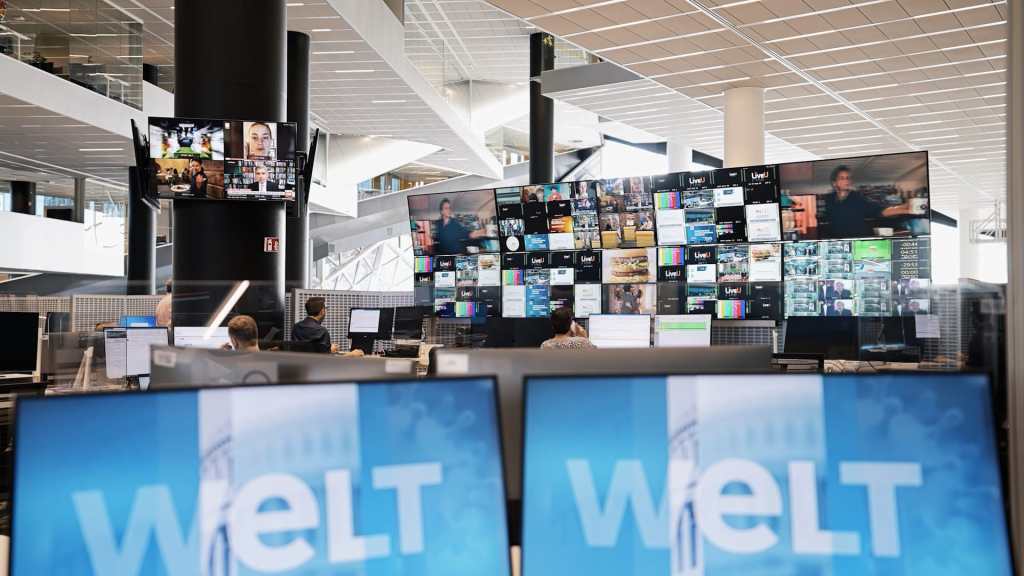
Welt’s requirements-creativity enhancement with simplified technology
Creativity enhancements with simplified technology. “WELT had several ideas, both creative and technical,” says Philipp Kern. “The creative ideas included a hybrid augmented reality (AR) studio and a physical studio with different creative layers, such as moving LED screens with content that can be in different positions and configurations around the studio, a cycloramic LED backdrop, and AR graphics”.
WELT wanted a unified workflow that would simplify and control the many inputs and outputs for production at the touch of a button. It needed redundant systems for operational security but didn’t want the rack space crowded out with extra hardware. In short, it wanted to have more flexibility while depending on fewer components.
“We wanted to give the day-to-day production the possibility to take all the media elements and put it together in a form they wanted and give the journalists the ability to put their ideas directly on screen,” adds Kern.
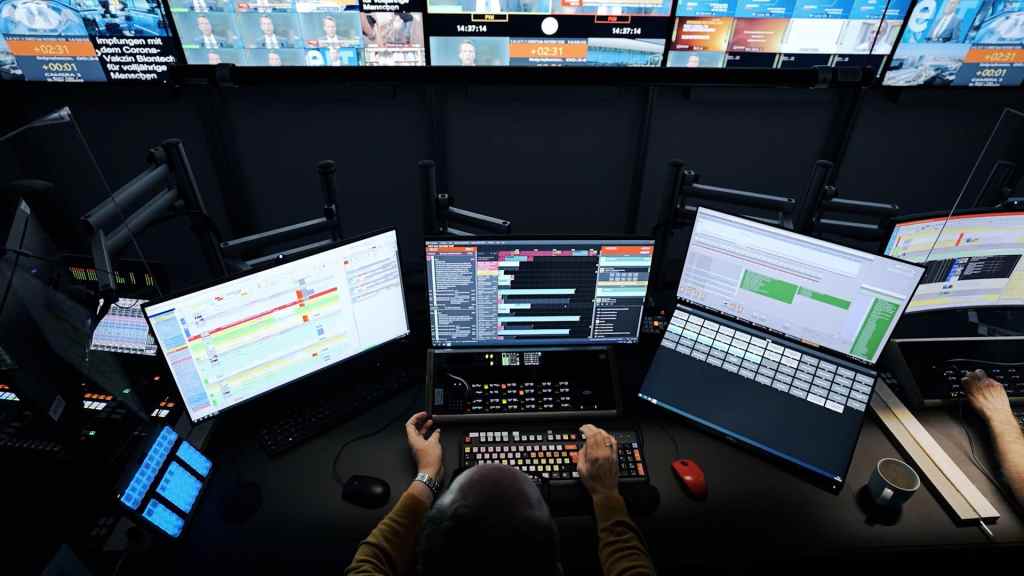
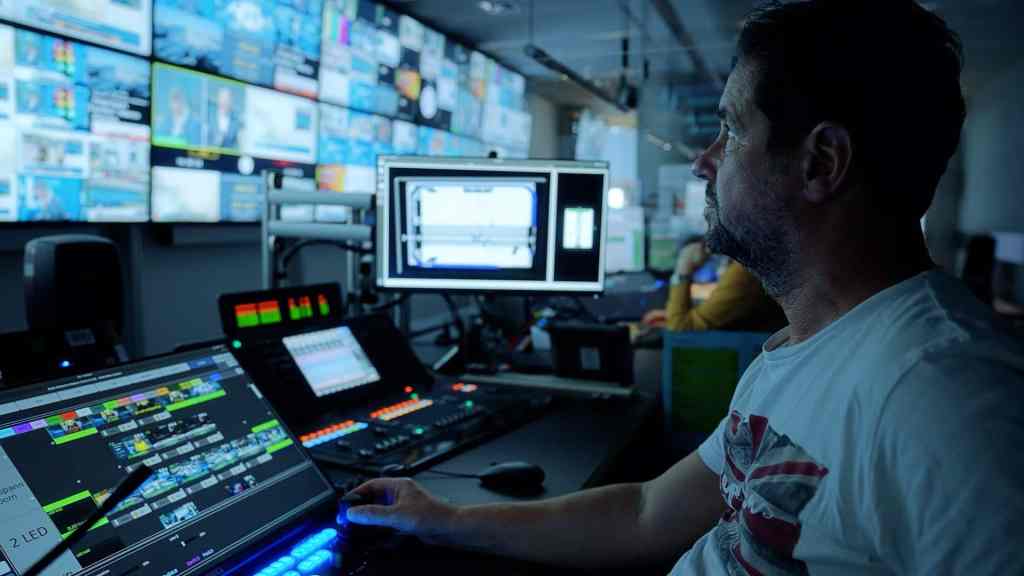
Automation
WELT wished to have a studio that offered maximum automation through robotic cameras and IP-controlled lighting systems. The moving LED panels, which could be arranged to form different backdrops, would need to be filled with content as well as maneuver according to the needs of production. WELT also wanted to be able to switch over to a completely virtual studio newscast in a matter of seconds or transition seamlessly when adding live sources as contributors to a current broadcast and redesign the screen on the fly.
All this would demand precise control and a lot of material to be generated, not just the normal news show media such as video feeds and graphic overlays, but the content for the screens and backdrop, the virtual studio, and the AR graphics. WELT wanted more scope for creativity but also required less complex routes to deploy and update its graphics output.
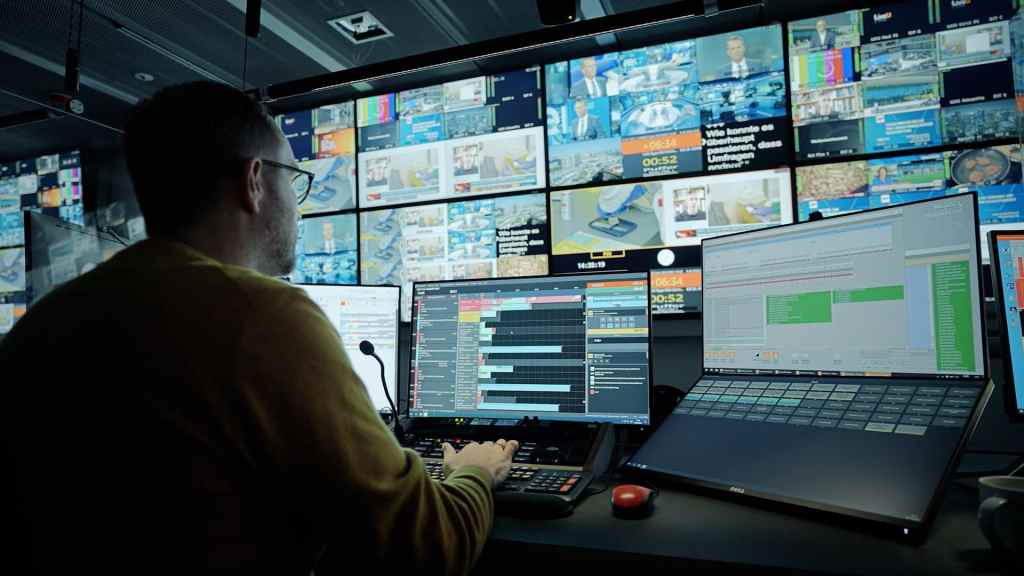
The challenges
“We had the problem of constantly moving visual data, such as that originating from the creative department using Cinema4D, moving that into Vizrt or another graphic system and then moving that into Viz Mosart which then fed the video switcher. This meant the original creative assets were being translated a second or third time,” says Kern. It was plain to see that modern storytelling might end up involving a lot of extra complexity, and a lot of hardware.
Solutions
However, the WELT team was thinking outside the box. Rather than have fixed hardware components routed through copper SDI to a hardware mixer in the gallery, they saw the potential in software, namely a SMPTE 2110 NMOS-based networked solution to build on the automation already in place.
“We had the idea to input the graphics directly into software and control all the broadcast media in one real-time software environment,” says Kern. Vizrt offers an advanced range of software solutions for media management, automation, and graphics that the broadcast engineers at WELT were already very familiar with. A long-established relationship has seen Vizrt develop specialized solutions for WELT over the past twenty years. Thanks to tools such as Viz Mosart the daily production was completely automated and each pre-planned news show required only two to three people in the gallery.
Customized unified workflows
“They wanted to have more unification,” adds Lang. “So, we had to create unified feeds for the LED panels and monitors inside the studios, to drive the virtual set and define the look and feel of the programs, as well as deliver the graphics that are needed to tell their stories. We wanted to streamline their operation to use very little components, so they were not trying to orchestrate a huge amount of technology to get to a certain look and feel.”
“Their idea was to integrate a lot of the workflows into one centralized solution and replace the hardware-based studio mixer with a software-based mixer,” says Adrian Fiedrich, R&D Project Manager at Vizrt. “We saw how we could modify and extend components to meet the new ST 2110-based workflow, and of course add a lot of new features to fit the customer’s needs. It’s a very tailored solution for WELT. Certain software components had to be introduced because those devices didn’t exist before and other products updated, but everything, all the various components, all the routing, is controlled by Vizrt products.”
In a traditional live studio environment, a vision mixer panel allows the operator to bring in and cue up media from video servers, graphics servers, clip servers, and live camera sources, all routed via copper cables.
Viz Engines influencing event-based logic

Everything runs on event-based logic, with Viz Engine providing the power. “Each gallery has at least four Viz Engines just independently switching network streams, all the time whenever they need,” says Fiedrich. “A new plug-in architecture was developed for the engine which takes care of requesting the source from the network, they talk to the system orchestrator which talks to the routers and it gets proper feedback as soon as the sources are switched.”
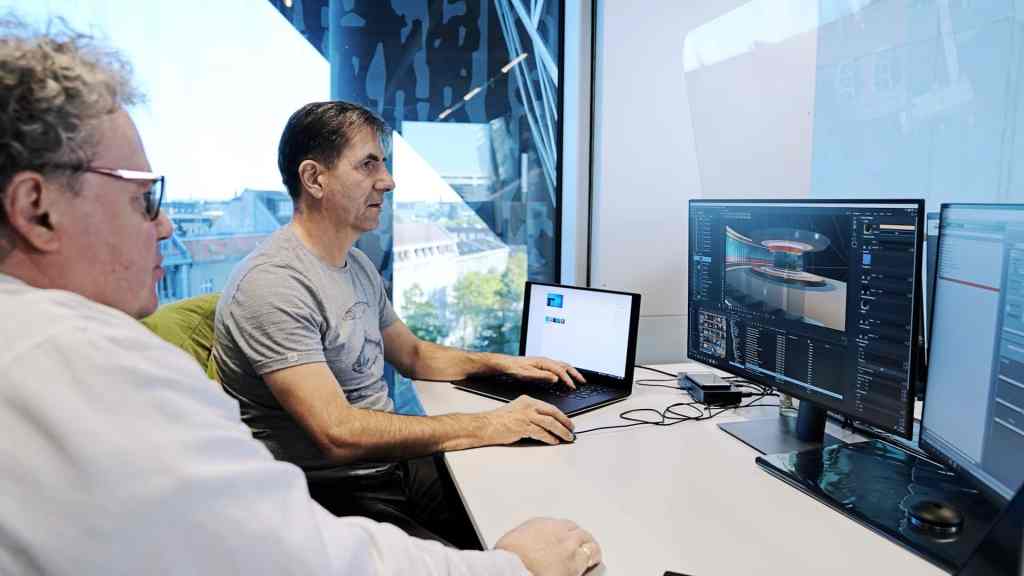
The whole system has a one-to-one redundancy. For example, it contains two vision mixers in parallel, always producing the same output. So, at any time, WELT can switch over to the backup and just keep producing the same show with the same functionality. Plugins listen to hardware inputs and will switch things over if something goes wrong. The system doesn’t rely on hardware with a fixed number of inputs or outputs. Instead, it can have many ‘instances’ running on the same machine to provide different kinds of output, such as a different aspect ratio. It can thus be easily scaled up not only in size but also in functionality. Viz Engine supports WELT’s seven cameras because of the way the mixer-less workflow can switch them. “Camera control is something we’ve been doing for years,” says Fiedrich. “This system just asks them to select the cameras they want to have, and the camera positions are handled by the robotic interface.”
Software-Driven automation
Due to the software-based environment, previously discrete devices can communicate with each other a lot more. So the vision mixer can talk to the camera tracking system as well as drive functions like tallies. It’s a similar setup for the IP-controlled lights; the system just wants to know which lights to use and the brightness levels and everything is automated.
The massive cyclorama video wall is also driven by Viz engine. It can be controlled directly via Viz Multiplay or automated by Viz Mosart.
“You can have the whole program rundown completely automated or have an operator hitting ‘next’. But there is no hardware vision mixer, and no panel and no copper-based routing, because the switching at the backend is all now completely dynamic,” says Fiedrich.
“As soon as you accept the rundown, then all you need to do is press play,” he continues. “You no longer need the person who controls the audio mixer because this is done by Viz Mosart; there is no video mixer because the engine itself knows what comes next and mixes it. It handles all the content, such as combining graphics and clips and compositing different layers of graphics on top. It all just switches.”
An eco-friendly practice
Sustainability concerns are also satisfied. “If you look into the WELT server room where the hardware now sits, there are just standard HP machines pulling a few hundred watts, rather than the power required for hardware video and audio servers, clip servers, and huge mixer panels,” Fiedrich adds. “They only need a rack, instead of a whole room.”
Tried and tested
The full development period was one and a half years, much of which took place during the lockdown and social distancing restrictions Germany was operating under due to COVID-19. However, work advanced greatly from October 2020 to April 2021, with Vizrt and WELT teams working together with solution integrator, Qvest Media.

“WELT was the first to think about these particular dynamic workflows at this scale,” says Fiedrich. “So we had to be the first to have to find the solutions. There was already a huge level of trust in us to achieve the things they wanted to do. It was good to have such a strong partner because what we are doing at WELT hasn’t been done anywhere before.”
“But the best thing we’ve heard is some of the users saying there’s no difference between a real video switcher and the Vizrt software.”
“This solution has run since April 24 without any problems at all. It’s incredible.” “The journalists have more direct responsibility for the show and it gives the day-to-day production more possibilities when putting the show elements together. We are now working with colleagues to integrate the virtual environment in Studio 2 with a real environment,” adds Philipp.
Although the system very much reflects what WELT originally requested, and so is tailored to that customer, the Vizrt components have been developed to be easy to adapt to the needs of other customers.
“We see this project as the prototype for this way of working,” says Fiedrich. “There are already other customers in Germany who are starting to create some test setups on a smaller scale, and we are looking at how the system can work for them.”
“We wanted maximum flexibility for modern storytelling”
